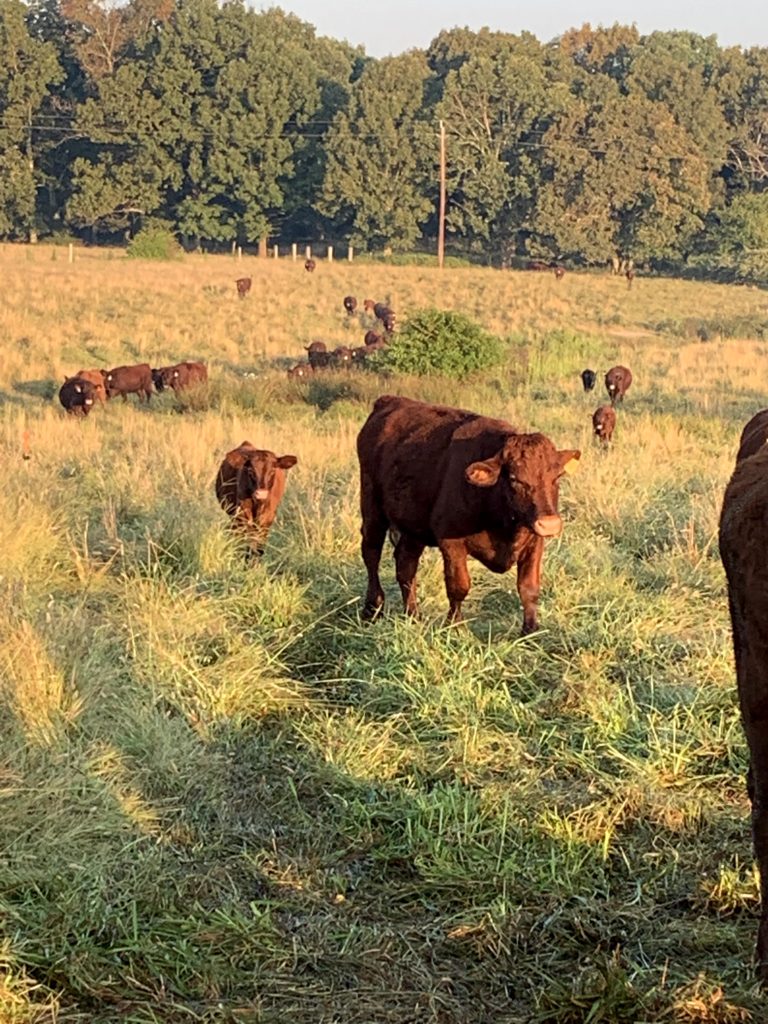
For farmers just starting out, this is a question that I hear quite often. The answer, and I know people hate it, is that it depends. There are so many variables involved. Soil PH, annual rainfall, does all your rain come in one season or is it spread out through out the year, pasture diversity and types of forage available all determine how many cows you can have on your farm.
For starters lets go over some vocabulary. When asking how many cows can my forage feed for a year, you are really asking about stocking rate. This is the total number of cows that your farm can feed based on the amount of forage it can produce. Stocking density is a term that often gets confused with stoking rate. Stocking density describes how many pounds of animal you have on a given area of your pasture. If you are continuously grazing, you divide the number of acres by the estimated weight of your cattle. If you break you pasture into paddocks and rotate your cattle, you divide the acreage of the paddock by the estimated weight of your cattle.
To determine the available forage of you farm, you can contact your local NRCS and they should be able to give you a pretty accurate estimate based on typical yields in your area. If you are looking for a more precise calculation of available forage in your pastures, ask your local NRCS for a grazing stick. There are several you tube videos explaining how to calculate the available forage with a grazing stick. The grazing stick is basically a ruler on one side and formulas on the other sides. You will measure the height of your pasture in 15-20 random spots. You will then estimate how much ground cover by looking directly down at where you are standing. The formulas use 3 categories: less the 75%, 75-90%, and greater then 90% soil coverage. Using the forage you will then need to determine the types of forage that exist in your pasture. The University of Kentucky has a very useful guide for South Eastern States at http://www2.ca.uky.edu/agcomm/pubs/agr/agr191/agr191.pdf

After you have determined the amount of available forage, you must determine your utilization rate. Most rotational grazers follow the take half leave half mantra. If you are under 75% coverage and you grass is less then 6 inches, we recommend only grazing 25% and then providing adequate rest.
Once you have your available forage and utilization rate determined you must understand animal units. One animal unite is one cow or cow calf pair weighing 1000 lb. An animal weighing 800 lb will be 0.8 AU and a cow weighing 1200 lb will be 1.2 AU. An animal unit will consume 2.5-3% of its of its body weight and will typically consume an average of 800 lb of forage in a month. This is called an AUM or animal unit month. The AUM is the standard, fixed variable used in all stocking rate calculations, no matter the forage type or resource, and no matter what animals you are grazing.
Now that you have figured out your available forage, your utilization rate you can calculate your stocking rate. The formula for stocking rate is (Forage Yield (lb/acre) x (Utilization Rate (%)/100)) / AUM.
In the following example we use an estimate 100,000 lbs/ac of forage yield.
Stocking Rate = Available Forage
Pounds Eaten/Month
Stocking Rate = 100,000 lbs/ac
800 lbs/month
Stocking Rate = 125 animals/month
If you are just starting out with cattle, I recommend only stocking a quarter of what your calculations say your stocking rate should be. This way you can observe for a year and see how your pasture responds. If you have a monoculture, little to no diversity in pasture forages, this will allow you to make observations throughout the year as to the available forage in different seasons. Worst case scenario is that you end up with to much pasture in the spring and summer and can stockpile parts of your pasture for the winter to reduce your need for supplemental feed.
Example farm with 50 acres:
If I were starting a farm with 50 acres of mostly fescue, I would purchase a bull, 9 heifers, and 5 steers. If there was no interior fencing and I had a single large paddock, I would invest in a couple reals of poly wire, pigtail post, and a 6 joule or greater fence charger. My first year I would use the poly fence to divide the pasture into 10 different 5 acre paddocks. I would move the cattle every 3 days. Observe how your pasture responds to rest. As you get more comfortable rotating the cattle, provide them with 20 different paddocks of 2.5 acres and keep them there for 2 days. The optimal rest is 60 days of rest. This would require dividing your paddock into 60 different paddocks slightly smaller then an acre each and rotating them every day.
Soon you will gain the experience to observe what the grass is telling you. In the spring when the grass is growing rapidly, you will give them larger paddocks and rotate them faster. The cows will mostly eat from the top of the plant. This time of year, a 30 day rest is all that is needed. As you progress into the warmer summer days, you will see the grass growth slow and you will give the cattle smaller paddocks with longer rest between grazing. If you still have to much grass, starting in the middle of July, fence off a section of your pasture and eliminate it from the rotation until the rest of the pastures have gone dormant in the winter. This stockpiled hay will be as good as if not better nutritionally then any stored hay.
After your first year you will be able to determine if you had to many cattle. At this point you can sell some of the steers to reduce your heard and retain your breeding stock. Alternatively, you can buy in more stock as needed if you had to much pasture.
